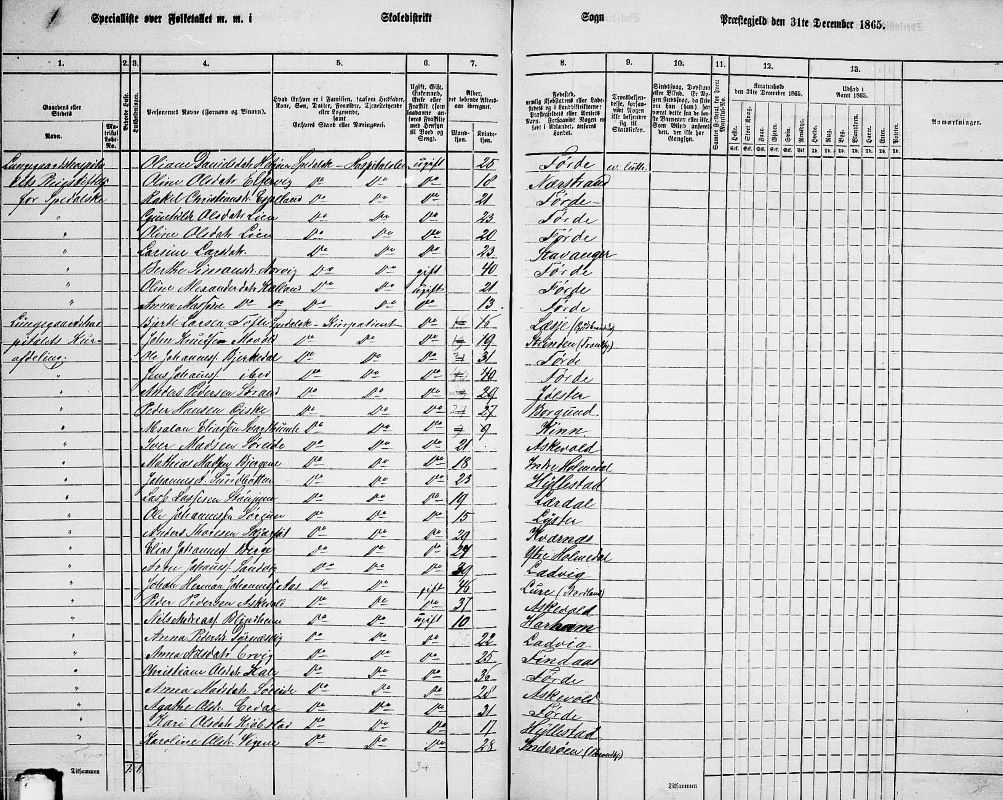The hospital’s residents in 1865
The censuses carried out in the latter half of the 19th century provide some glimpses of what life was like at Lungegård Hospital. All those living at the hospital on the day of the census were recorded in the census forms, with their name, age/year of birth and often their place of birth.
The first census took place on 31 December 1865, just a few years after the new Lungegård Hospital was completed. There were 88 patients at the hospital on that day, 43 on the hospital’s care ward and 45 in the curative ward. There were also 18 staff living at the hospital.
Who knew whom?
The patients shared life at Lungegård Hospital over short or long periods of time. Men and women lived separately, and had separate dining rooms where they were given regular meals. Some patients lived together in the same room, they worked together, and perhaps even bathed together as part of their treatment. They may have also spent time together in the large park, where they could go for a walk.
It’s impossible to know which patients knew each other, who spent time together and formed friendships, or who fell out with each other. It’s possible that patients of a similar age formed a bond, or perhaps there were friendships across age groups. Patients that came from the same area may have known each other before they came to the hospital.
It’s easy to imagine that the youngest patient in the curative ward – and in the entire hospital – nine-year-old Absalon Eliassen Svartthumle from Kinn, spent time with ten-year-old Nils Andreassen Blindheim from Haram. The hospital had its own school for the children and adolescents who were hospitalised, so they would have got to know each other there, but did they also have the opportunity to hide away, play and forget that they were sick?
We can also imagine that 12-year-old Anna Andreasdatter Andal from Førde may have struck up a friendship with Christine Hermundsdatter Lie from Hafslo, who was only a year older. Perhaps 16-year-old Thrine Jacobsen, 17-year-old Kari Olsdatter Kjøbstad and 18-year-old Dorthea Pedersdatter Bøthun also spent time together. There were also two boys aged about 15 or 16, and two 19-year-old boys.
That being said, people at the hospital may not always have lived in harmony. Fear, pain, homesickness and the thought of a future in the hospital may have created a lot of frustration. The patients were living in close quarters, with several patients sharing a room. We know from Pleiestiftelsen Hospital that an elderly man was hit in the head with a bottle and later died from his injuries. Some patients were also expelled due to violence, some were transferred to mental asylums, and several escaped.
Siblings at the hospital
The overview of residents includes patients who are presumably siblings. Iver Madsen Søreide, 21 years old, and Anna Madsdatter Søreide, 28 years old, both came from Askevold and were in the curative ward. Since men and women lived separately, it is likely that they seldom had contact with each other. It was no doubt easier for the two brothers Ole and Jens Johannessen Bjerkedal from Førde, aged 31 and 40, or 11-year-old Anna Massine Alexandersdatter Kalland and 21-year-old Oline Alexandersdatter Kalland, two girls from Førde who were probably sisters and were staying in the care ward.
Age distribution
There was a broad age distribution in the care ward, from the youngest girl aged 11 to the oldest resident, 73-year-old Lars Jacobsen Berg from Førde, who was born in 1793. In contrast, there were no patients over the age of 46 on the curative ward, and almost half were under the age of 30. It was believed that the best candidates for treatment were those who were young and whose leprosy was not advanced. The vast majority of patients were from Sunnfjord and Sogn, which corresponds with the areas that were hardest hit by leprosy. It does however seem a bit peculiar that, in 1865, more than half of the patients in the care ward were from Førde. Perhaps Førde had a particularly zealous district medical officer or a poor commission that wanted to shift the financial burden of caring for the sick onto the state.
It cannot have been easy for anyone being admitted to a leprosy hospital, but it must have been particularly hard for children aged nine or ten to have to leave their families and move into one of the hospitals in Bergen.

Hospital staff
There were several staff members living at the hospital in 1865, including the 29-year-old assistant physician Nils Nicoll, who was from Christiania, and the 39-year-old superintendent Andreas Edvard Borge from Årstad. He was a widower and lived there with his three daughters: Mathilde Marie, aged 11; Anna Edvardine, aged 8; and Milla Oluffa, aged 6. The assistant physician and the superintendent lived in the staff residence east of the main building.
There were also other staff, including housekeepers, kitchen maids and ward orderlies, living in the central wing of the hospital. There were also a male and a female bathing attendant and a cup setter on the staff. In addition, there was an errand runner, who would run errands in the city, a stoker and a porter. It is possible that one of the housekeepers and a maid lived in the staff residence.



